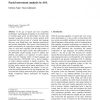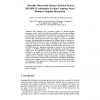38 search results - page 3 / 8 » Sign: A Framework to Write Sign Languages |
116
click to vote
UAIS
2008
14 years 11 months ago
2008
In the age of speech and voice recognition technologies, sign language recognition is an essential part of ensuring equal access for deaf people. To date, sign language recognition...
CVPR
2007
IEEE
16 years 1 months ago
2007
IEEE
One of the hard problems in automated sign language recognition is the movement epenthesis (me) problem. Movement epenthesis is the gesture movement that bridges two consecutive s...
117
click to vote
ICIP
2008
IEEE
16 years 1 months ago
2008
IEEE
Reliable segmentation and motion tracking algorithms are required to achieve gesture detection and tracking for human-machine interaction. In this paper we present an efficient me...
117
click to vote
ICMI
2005
Springer
15 years 5 months ago
2005
Springer
Sign language recognition (SLR) plays an important role in human-computer interaction (HCI), especially for the convenient communication between deaf and hearing society. How to e...
100
click to vote
HCI
2009
14 years 9 months ago
2009
Sign language (SL) recognition modules in human-computer interaction systems need to be both fast and reliable. In cases where multiple sets of features are extracted from the SL d...


